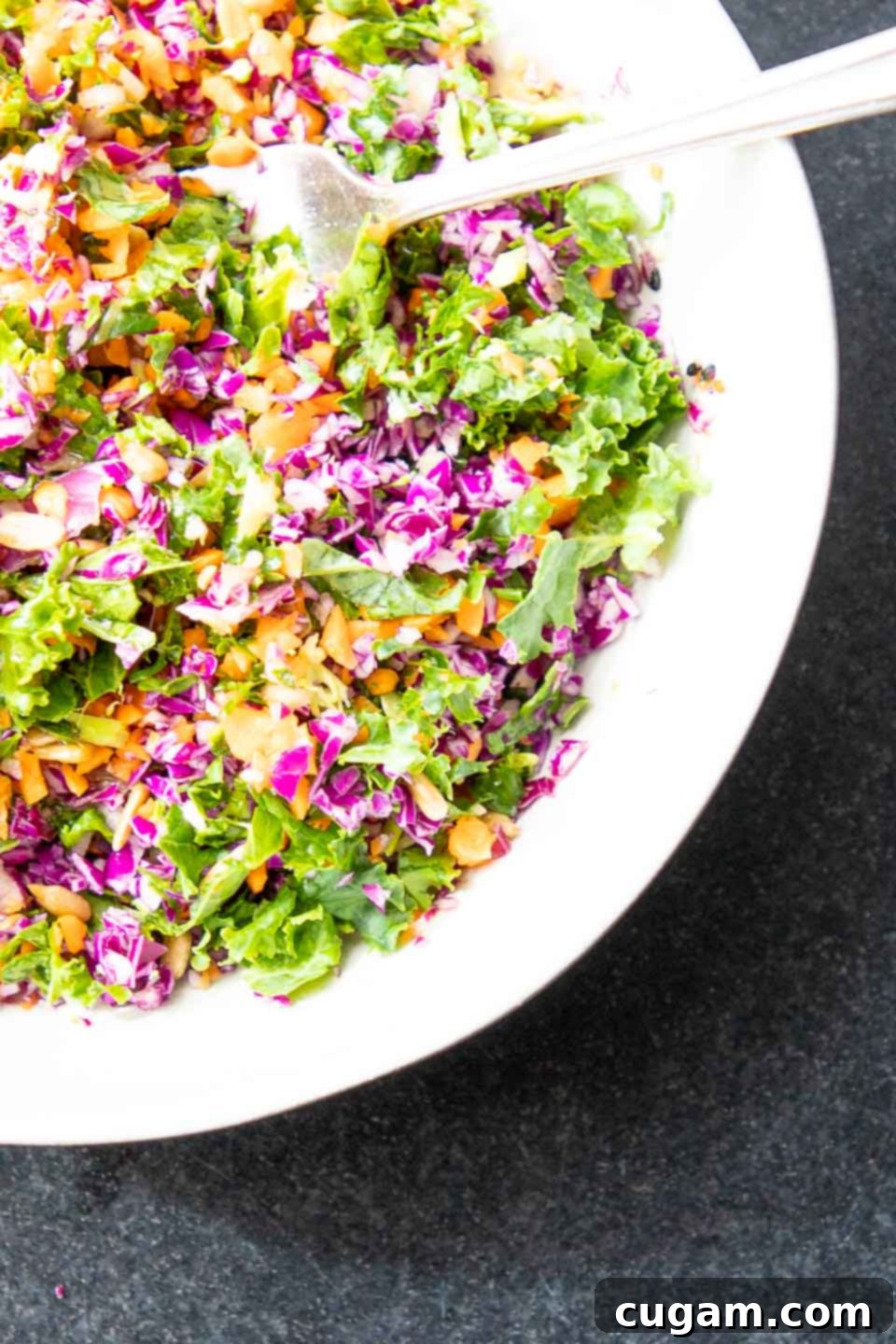Easy 5-Minute Food Processor Chopped Salad: The Ultimate Healthy Meal Prep Recipe
Imagine turning a variety of whole, fresh vegetables into a perfectly chopped, vibrant salad in a mere five minutes. Sounds too good to be true? Not with the magic of your food processor! This revolutionary approach to salad preparation eliminates the need for extensive knife skills and precious time, making healthy eating accessible and enjoyable for everyone. Whether you prefer a finely textured blend or a more chunky, rustic chop, your food processor is the secret to elevating your salad game to an entirely new level.
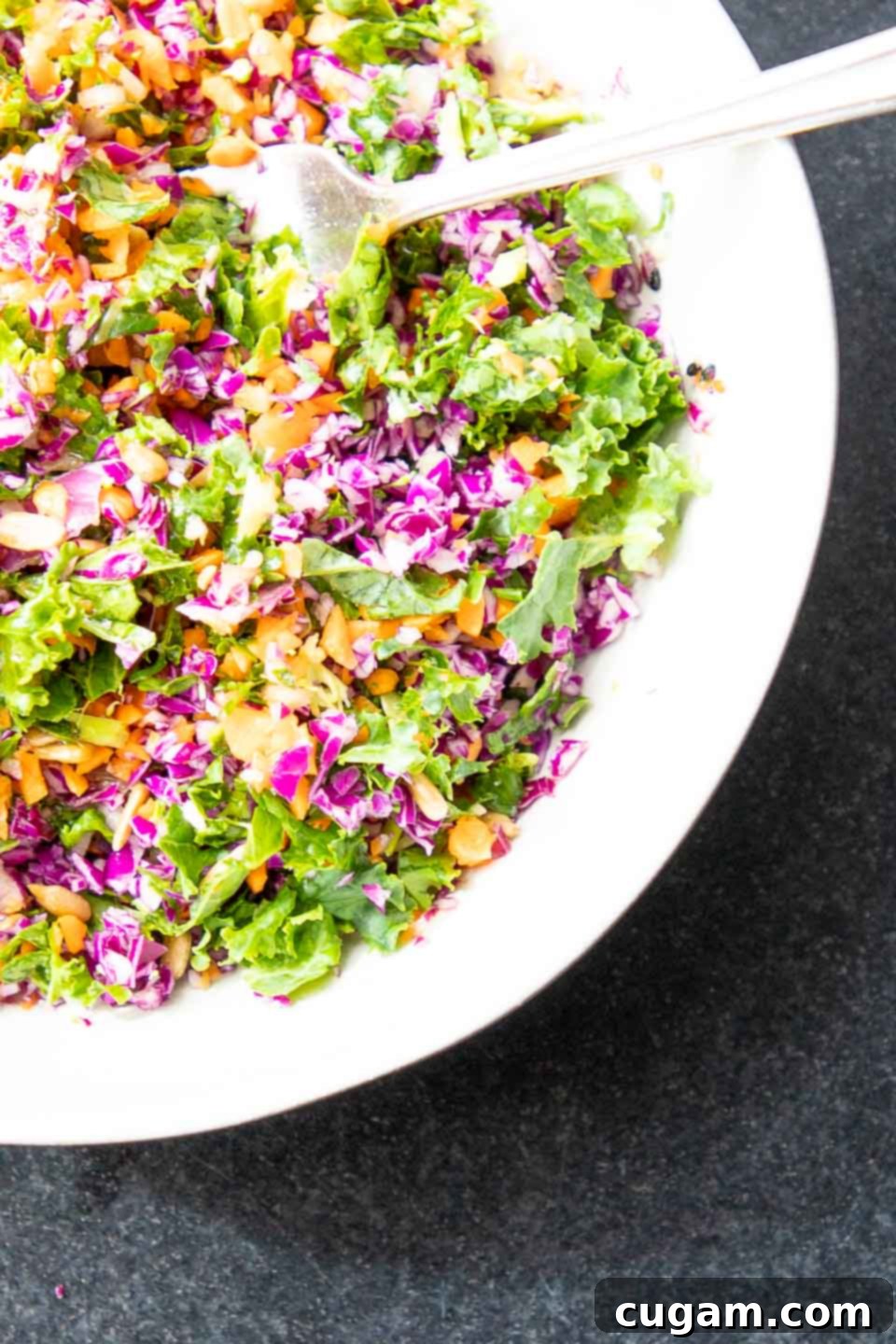
This post has been updated from the original posted October 19, 2019.
[feast_advanced_jump_to]
Revolutionize Your Salad Making with a Food Processor
Do you love the concept of a crisp, wholesome chopped salad but dread the laborious process of preparing it? You’re not alone! Many aspiring healthy eaters find themselves deterred by the time and effort traditionally involved in chopping numerous vegetables. The good news is, creating a delicious and nutritious chopped salad doesn’t have to be complicated or time-consuming. This recipe unveils the power of your food processor to transform a handful of whole vegetables – whatever you have on hand in your crisper drawer – into an amazing chopped salad in under five minutes. Yes, you read that right: whole veggies to a ready-to-eat chopped salad in just 5 minutes! Get ready to embrace a new era of effortless healthy eating.
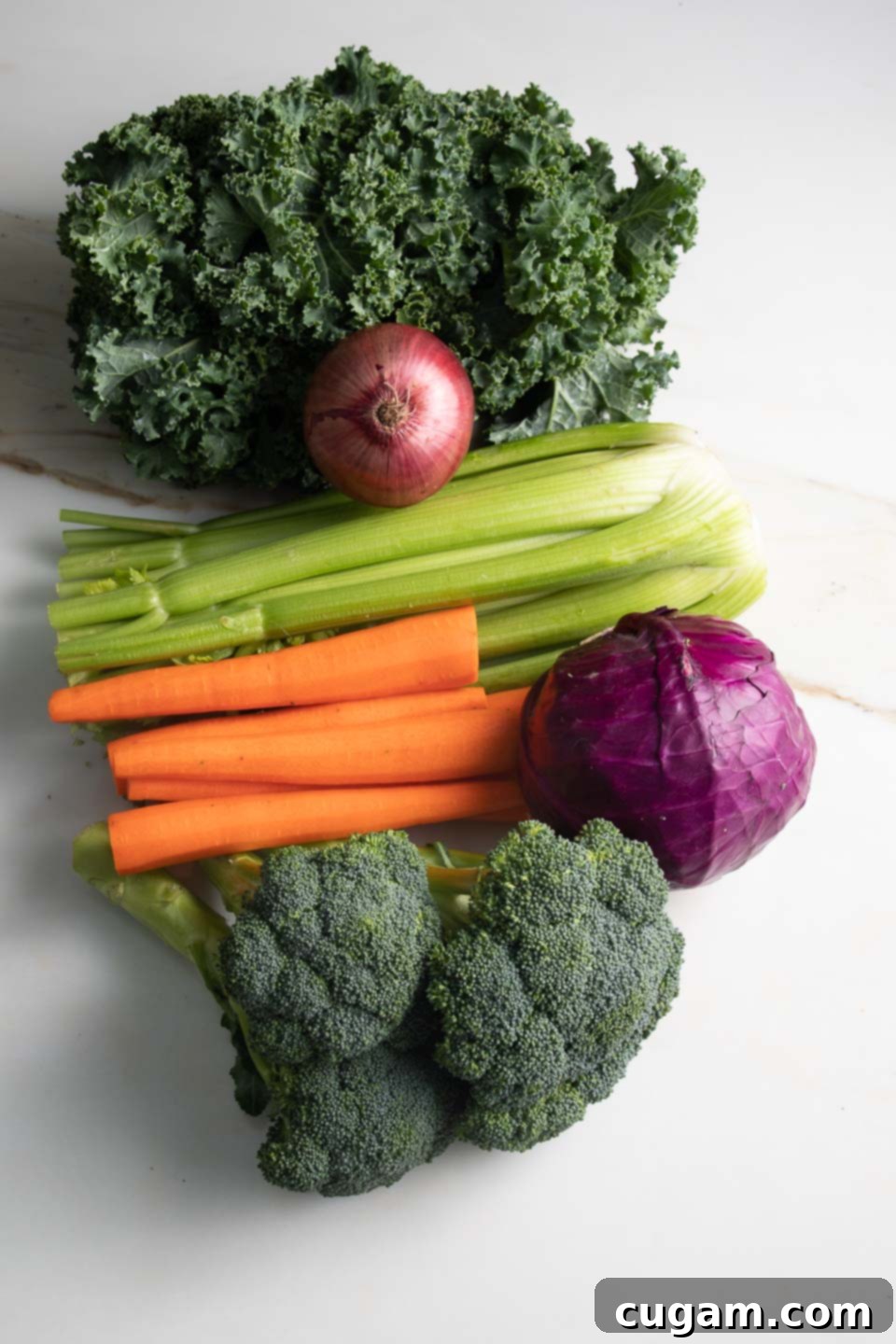
The 5-Minute Chopped Salad Recipe: Your Shortcut to Health!
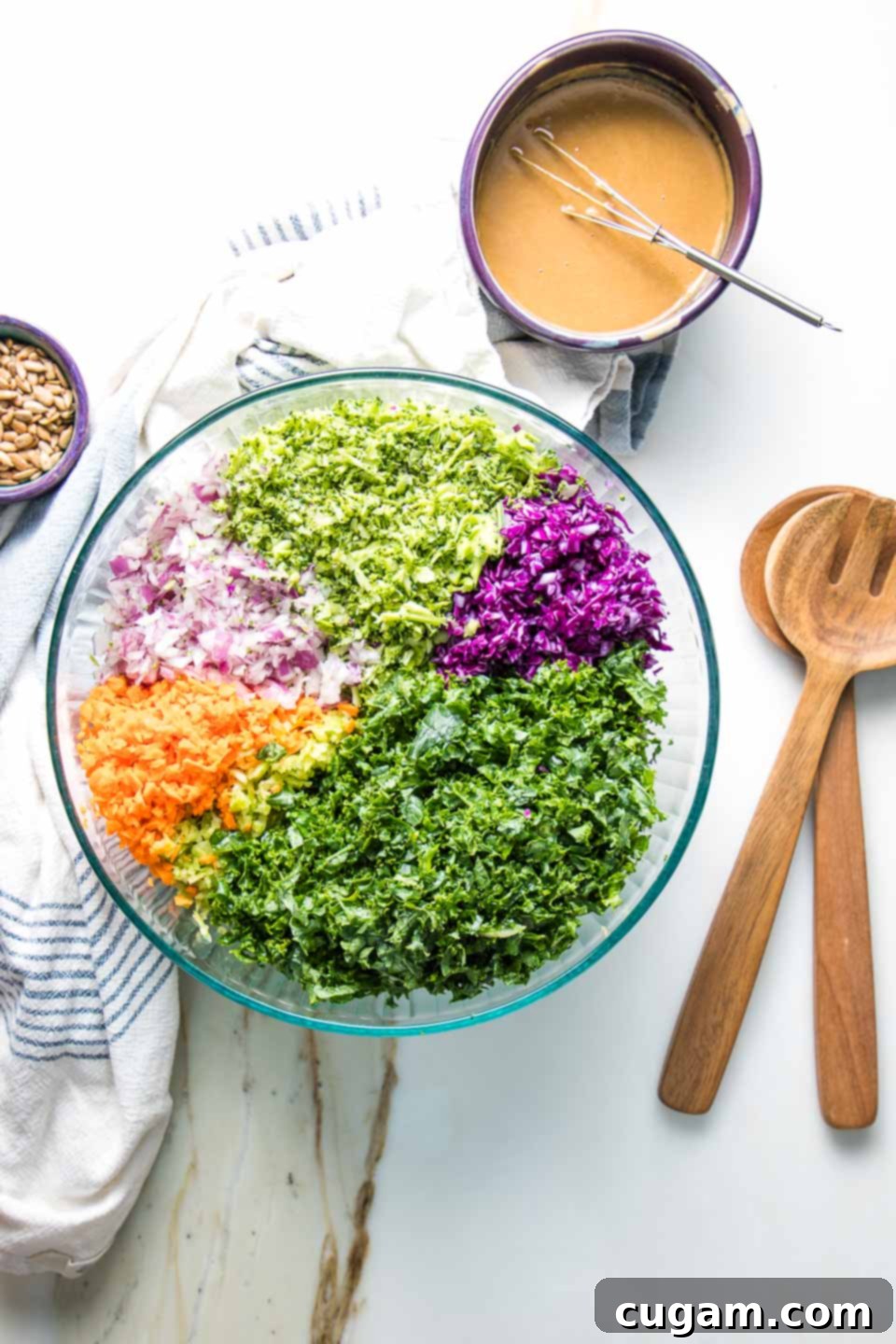
How to Master Vegetable Chopping with a Food Processor
While some find the rhythmic art of chopping vegetables by hand a meditative and therapeutic experience – armed with a sharp knife and a sturdy cutting board – for many, it’s a dreaded chore. My clients and friends often voice their reluctance to spend time on this task, seeing it as a barrier to preparing healthy meals. This is exactly why I developed this food processor chopped salad recipe: to remove that barrier and empower you to incorporate more nutritious, wholesome salads into your daily life, effortlessly. Lack of time is no longer a valid excuse when a gourmet-quality chopped salad can be ready in literally five minutes.
The key to perfect food processor chopping lies in understanding the pulsing technique and handling different vegetables. Most food processors come with an “S” blade (or a standard chopping blade) which is ideal for this task. The trick is to pulse, rather than continuously blend, to achieve a uniform chop without turning your vegetables into a purée. Start with larger, harder vegetables like carrots or broccoli stems, giving them a few pulses before adding softer greens. For best results, process each type of vegetable separately. This ensures consistent texture and prevents some ingredients from being over-processed while others are still too large. And don’t worry about cleaning the bowl between different types of veggies; it’s usually unnecessary when you’re combining them all into one salad.
With just a few quick pulses, you can achieve anything from a finely minced salad that’s almost spreadable, to a chunkier mix with satisfying bites of texture. This versatility allows you to customize your salad exactly to your preference, making every meal a delightful experience.
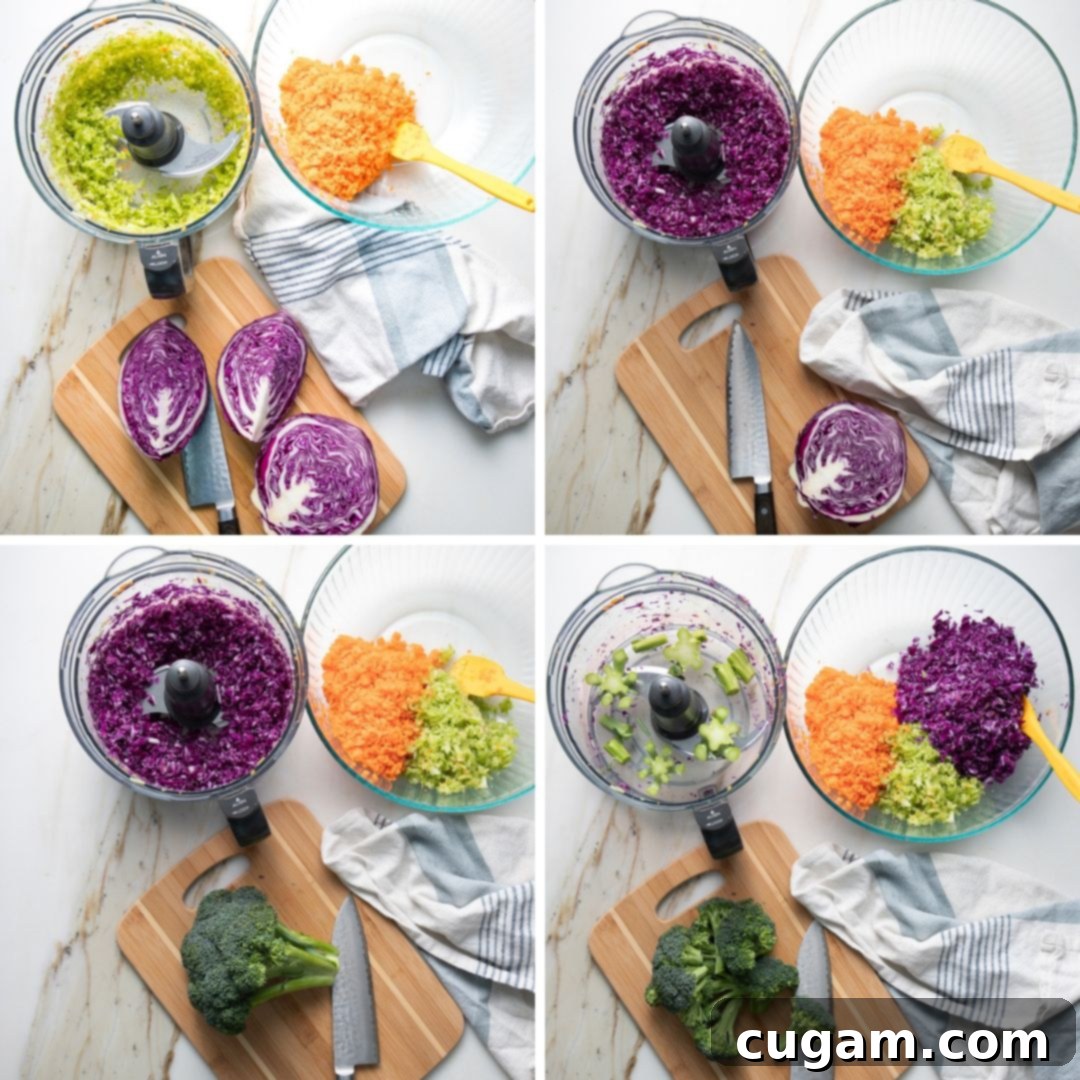
Is Chopped Salad Really Healthy? Unpacking the Nutritional Benefits
The food choices we make profoundly impact our health, steering us either towards vitality or towards illness. A chopped salad, especially one brimming with a diverse array of fiber-rich and antioxidant-packed vegetables, is an incredibly healthy choice. When paired with a wholesome, homemade dressing, it becomes a nutritional powerhouse. This 5-minute chopped salad recipe is your fast track to making a truly healthy and beneficial dietary decision.
Eating a wide variety of vegetables is crucial for fostering a diverse and robust gut microbiome. Emerging scientific studies consistently highlight the importance of this diversity for overall health, immunity, and mental well-being. Vegetables such as kale, cabbage, broccoli, and carrots are not only low in calories but are also densely packed with essential vitamins, minerals, and dietary fiber. By chopping them finely, you break down their cellular structure slightly, which can make some nutrients more accessible and easier to digest. A chopped salad loaded with these nutritional champions is not just a healthy choice; it’s a strategic investment in your long-term health, helping to prevent chronic diseases and maintain optimal bodily functions.
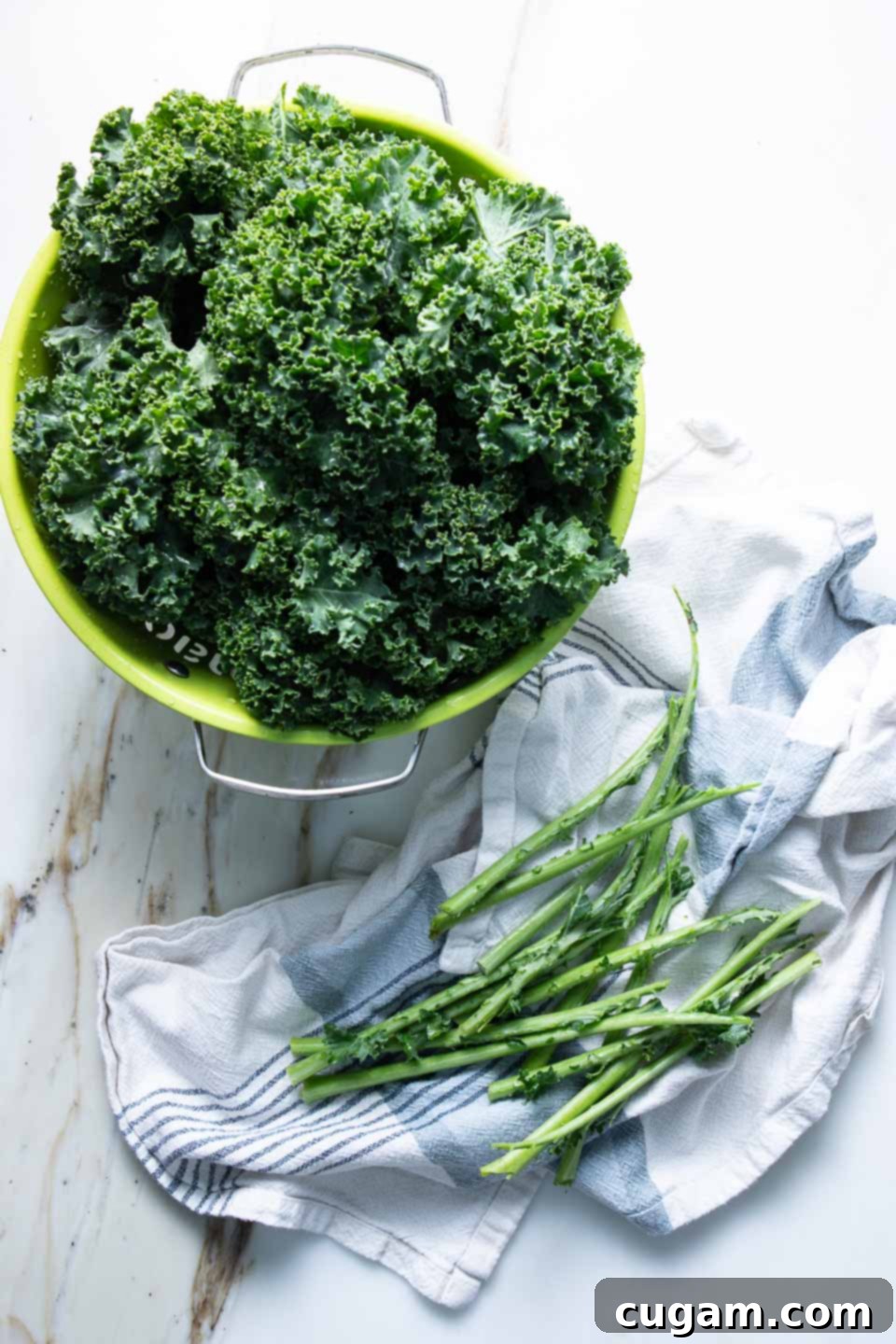
Crafting the Perfect Healthy Chopped Salad: What to Include
The simplest answer to what goes into a healthy chopped salad is: any and all vegetables! The beauty of this recipe lies in its incredible flexibility. The best chopped salads are a medley of textures, tastes, and colors. Think crunchy, sweet, earthy, and peppery notes all coming together. Each vegetable brings its unique profile of vitamins, minerals, and fiber while remaining low in calories. For a salad that stands up well to meal prepping and lasts for several days in the fridge, focus on heartier varieties, but don’t shy away from delicate greens for immediate consumption.
Consider these categories for building your ideal chopped salad:
- Hearty Greens: For meal prep that lasts all week, opt for robust greens like collards, kale, or Swiss chard. For salads you plan to eat sooner, romaine, baby kale, beet greens, arugula, or watercress are excellent choices. All these greens are nutritional powerhouses, rich in vitamins A, C, and K, as well as essential minerals and fiber.
- Crunchy Cruciferous Vegetables: These provide fantastic texture and a wealth of health benefits. Broccoli, cauliflower, cabbage (green or purple), Brussels sprouts, and radishes are all fantastic options that chop beautifully in a food processor. They are known for their anti-inflammatory and detoxifying properties.
- Sweet & Root Vegetables: Carrots and beets add natural sweetness, vibrant color, and a satisfying crunch. They are easily processed and bring a different flavor dimension. Don’t forget other root vegetables like parsnips or even sweet potatoes (though these might need a quick pre-cook for softer chopping).
- Alliums & Aromatics: Onions (red, white, or green), garlic, and bell peppers (any color) add essential flavor and powerful antioxidants. They are easy to chop and distribute evenly throughout the salad.
- Legumes & Proteins: To make your chopped salad a complete meal, consider adding cooked chickpeas, black beans, lentils, or even edamame for a protein boost. For non-vegan options, shredded chicken or hard-boiled eggs work wonderfully.
- Herbs: Fresh herbs like parsley, cilantro, dill, or mint can elevate the flavor profile dramatically. A quick pulse with the other veggies is often all they need.
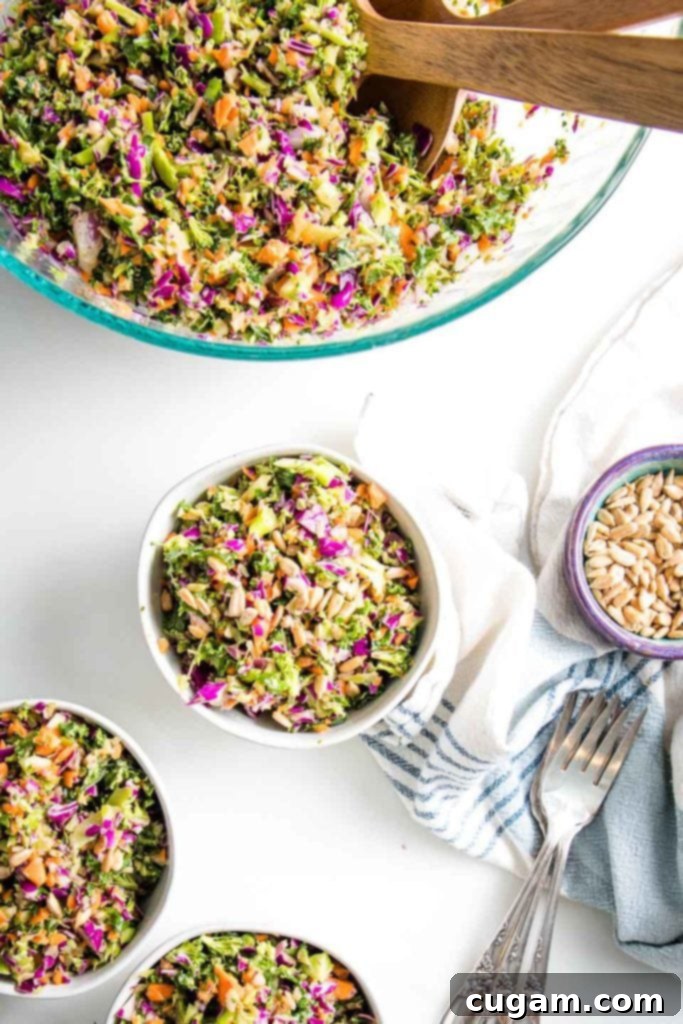
The Anatomy of a Perfect Chopped Salad
What sets a chopped salad apart and makes it so universally loved? It’s the delightful promise of getting a little bit of everything in each and every bite. Imagine a forkful perfectly balanced with crunch, varied textures, a symphony of flavors, and an explosion of colors. This harmonious blend is what makes chopped salads so incredibly satisfying and my absolute favorite way to enjoy a meal packed with fresh produce.
Beyond the taste experience, chopped salads offer practical advantages. The bite-sized pieces make them incredibly easy and graceful to eat, whether you’re at a casual lunch or a more formal gathering. No more wrestling with large lettuce leaves! This also makes them particularly appealing for children or anyone who might find traditional salads cumbersome. If you’re on a mission to increase your daily vegetable intake but find yourself bored with the same old traditional salads, this food processor chopped salad is your ultimate game-changer. It’s not just easy to prepare; it’s endlessly customizable. You can incorporate any vegetables you prefer or have readily available, ensuring zero food waste and maximum enjoyment. The ability to switch up your veggie combination and dressing each time you make it ensures that your healthy eating journey remains exciting and far from monotonous.
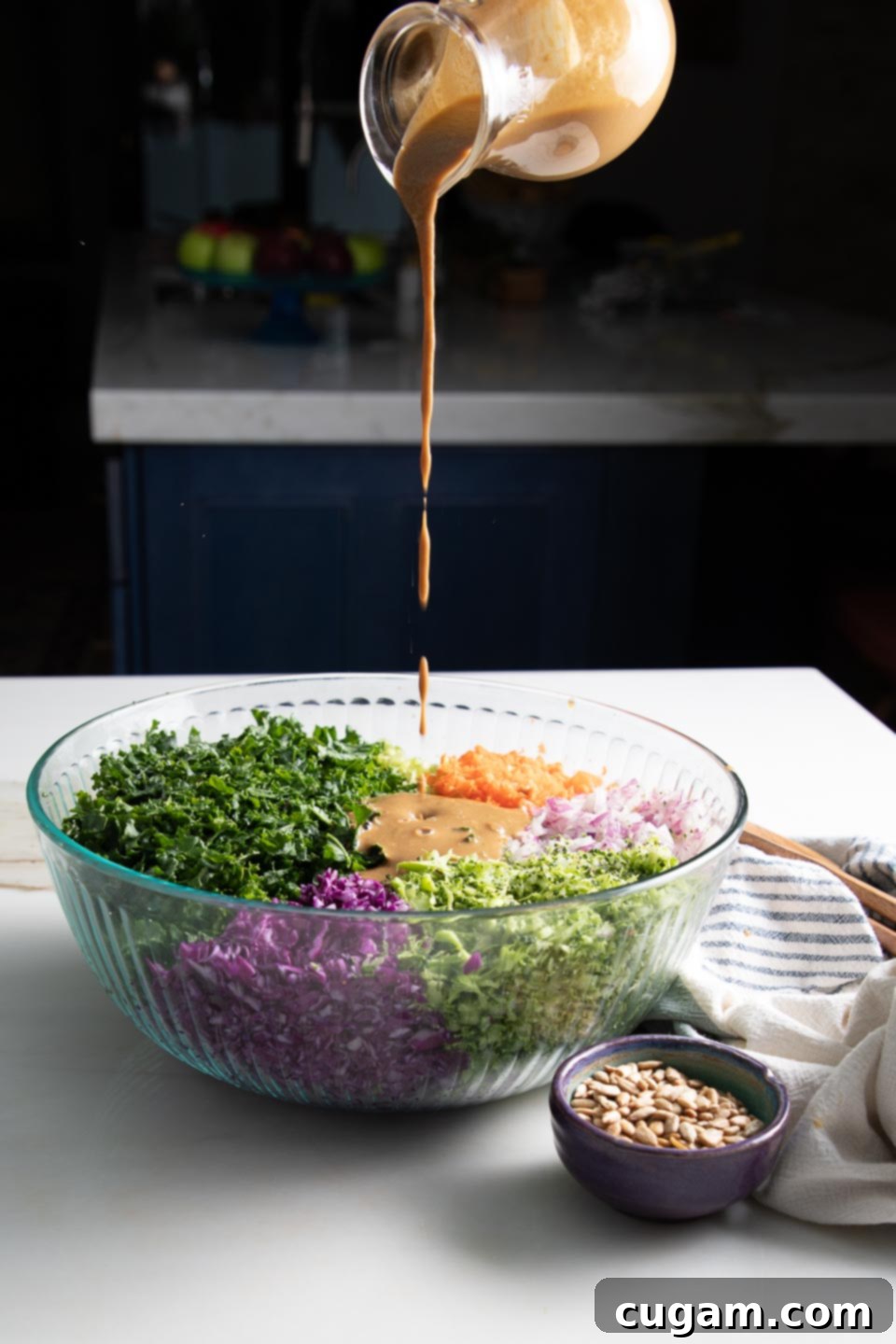
Elevate Your Chopped Salad with the Perfect Dressing
The dressing is the soul of any salad, bringing all the individual components together with a burst of flavor and a creamy or tangy finish. For this chopped salad, I typically gravitate towards a homemade tahini dressing. It’s a stellar choice because it’s quick to whip up, uses simple, wholesome pantry staples, and boasts a luscious, thick consistency that clings beautifully to every piece of chopped vegetable. Plus, this particular tahini dressing recipe requires no added oil, making it an even healthier option.
However, the beauty of a chopped salad is its versatility, and you can completely transform the taste experience by experimenting with different dressings. If you prefer a lighter, less creamy option, my everyday salad dressing recipe is fantastic. It requires no special equipment, relies on basic pantry ingredients, and is ready in just two minutes. For a refreshing and herbaceous twist, try a green goddess dressing. Or, if you’re in the mood for something with a zesty kick, a chipotle dressing adds an incredible smoky flavor. The possibilities are endless, allowing you to tailor your chopped salad to your cravings and preferences every time!
Essential Ingredients for a Healthy No-Oil Tahini Dressing:
- TAHINI: This sesame paste forms the creamy, rich base of our dressing. When selecting tahini, look for brands with just one ingredient: sesame seeds. Tahini is not only delicious but also a good source of calcium and healthy fats, which are crucial for absorbing the fat-soluble vitamins (A, D, E, and K) present in your greens. For a perfect consistency, remember my top tip: store unopened glass jars of tahini upside down in your pantry. Upon first opening, mix it thoroughly to achieve a uniform, smooth texture. This preparation will ensure it’s ready for all your favorite tahini recipes, from healthy brownies to low-carb cauliflower hummus or a vibrant green tahini sauce. If you have a sesame allergy, sun butter (made from sunflower seeds) is an excellent, equally creamy substitute.
- TAMARI: A gluten-free alternative to traditional soy sauce, tamari typically contains less sodium while offering a rich, savory umami flavor. It’s perfect for adding depth to dressings without excessive saltiness.
- RICE VINEGAR: Opt for an unsweetened variety of rice vinegar. Its delicate and slightly sweet flavor profile is milder than white vinegar, making it an ideal choice for a balanced and bright dressing.
- MAPLE SYRUP: Just a small splash of pure maple syrup is enough to perfectly balance the flavors of this dressing, adding a hint of natural sweetness without being overpowering.
- CAYENNE PEPPER: A modest amount of cayenne pepper provides a delightful kick that beautifully complements the other ingredients. Beyond its flavor, cayenne is known for its metabolism-boosting properties and its potential to aid digestion. Adjust the quantity to suit your preferred level of spice.
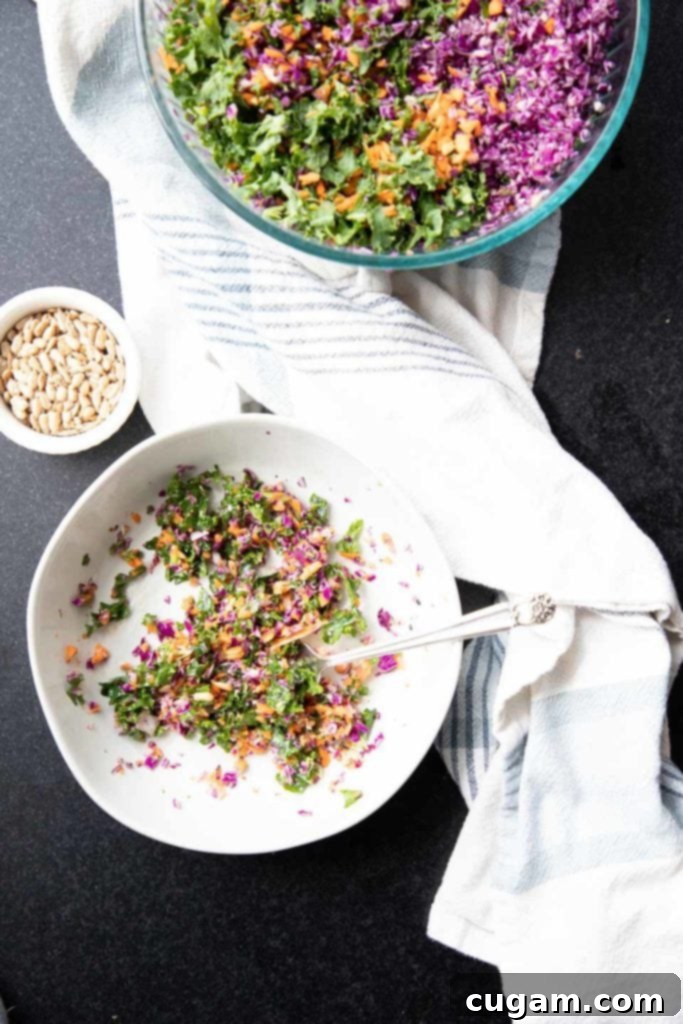
Master Meal Prep with Your Food Processor: Endless Possibilities!
No time to painstakingly chop a mountain of vegetables for your weekly meals? Your food processor is about to become your best friend for meal prepping! It effortlessly chops a wide array of vegetables, including even hearty greens like kale. Imagine having a week’s worth of finely chopped salad ingredients ready to go, without the usual time commitment. This not only makes healthy eating incredibly easy but also significantly reduces food waste by ensuring those beautiful veggies in your crisper drawer are prepped and enjoyed, rather than left to spoil.
While your food processor is out, seize the opportunity to chop enough vegetables to last you an entire week. Store these prepped ingredients in a large glass bowl with a tight-fitting lid. For optimal freshness, place a paper towel on top of the chopped veggies before sealing the container; this helps absorb any excess moisture, keeping your produce crisp for 5-7 days. Separately, prepare your favorite dressing and store it in an airtight container for up to two weeks, shaking it vigorously or re-whisking before each use.
The versatility of these pre-chopped vegetables is truly remarkable. Grab a handful, add your dressing, sprinkle some nuts or seeds, and BAM! A delicious, crunchy salad is ready. Integrate some leftover roasted vegetables and a different dressing, and BAM! You have an entirely new flavor experience. If you’re craving something warm on a chilly day, simply sauté your chopped veggies in a pan with a touch of olive oil and a pinch of crushed red pepper for a quick, unique stir-fry. With just five minutes of initial prep, you unlock endless culinary possibilities throughout the week, ensuring healthy and exciting meals are always within reach.
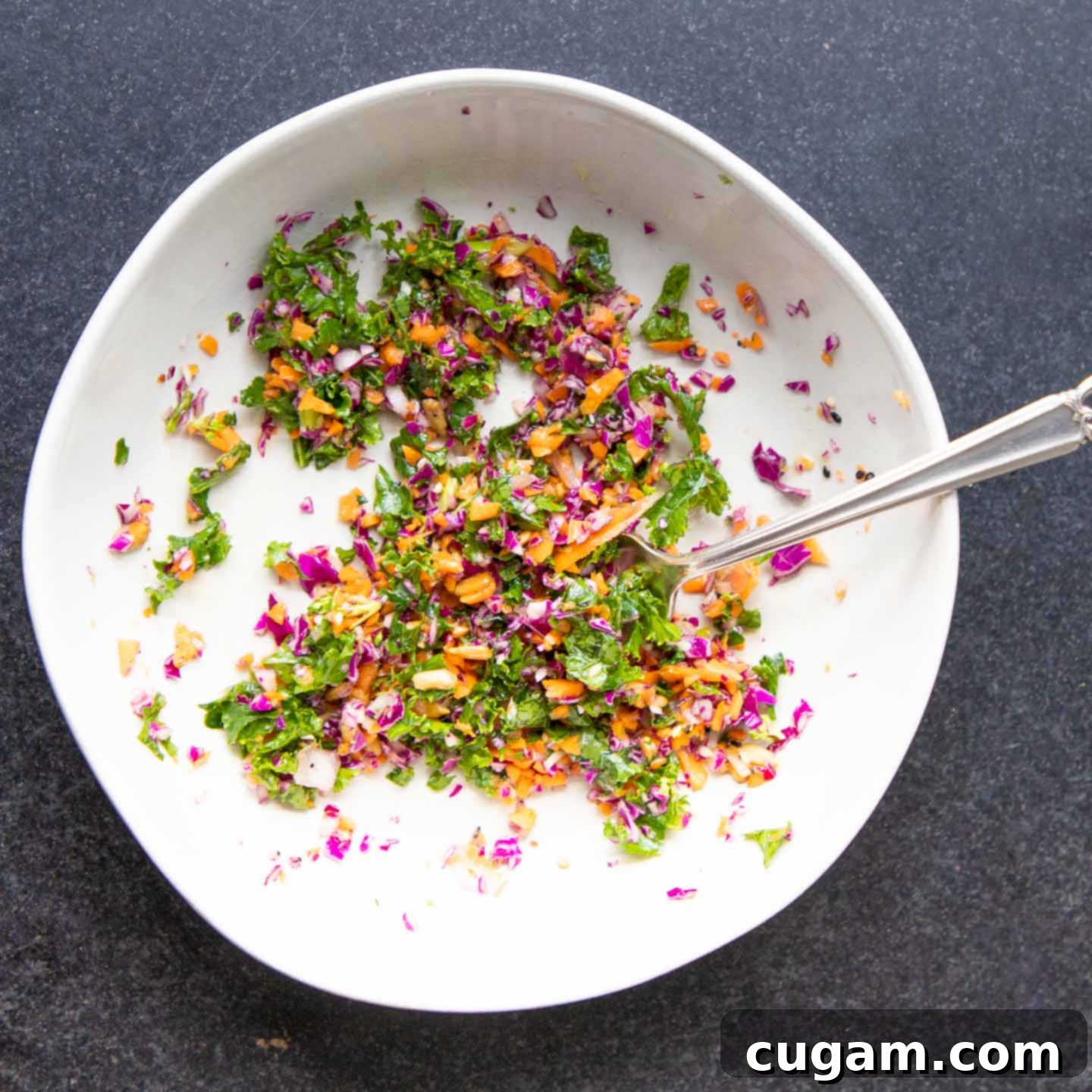
More Easy & Healthy Meal Prep Ideas to Explore:
- Raw Cauliflower Salad with Lime
- Instant Pot Mexican Pinto Beans
- Baked Steel Cut Oatmeal
- Hearty Vegan Lentil Soup
Did you know commenting and rating recipes is one of the best ways to support your favorite food bloggers? If you made this recipe, please consider a five-star rating below and leave a comment. Also, please share your photos on Instagram by tagging me @dkhealthcoach and using the hashtag #debraklein. Your feedback and shares are greatly appreciated!
📖 Recipe

Food Processor Chopped Salad Recipe
Rate this Recipe
Pin Recipe
Equipment
-
Mini whisks
-
Glass Mixing Bowls with Lids
-
Food Processor
Ingredients
- 3 large carrots
- 3 stalks celery
- 2 cups broccoli florets
- ½ small head purple cabbage
- 1 small purple onion
- 1 bunch curly kale
- ½ cup sunflower seeds
Sunflower Dressing
- ½ cup tahini***
- 2 Tablespoons unseasoned rice vinegar
- 2 Tablespoons tamari
- ¼ cup water
- 1 Tablespoon maple syrup
- ¼ teaspoon cayenne pepper
Instructions
-
Prepare Veggies: Start by preparing your vegetables. Peel the carrots, scrub the celery stalks clean, remove the core from the cabbage, peel the onion, and de-stem the kale. Once prepped, roughly chop each vegetable into large, manageable chunks. These larger pieces are ideal for processing in the food processor.
-
Chop in Food Processor: Using the “S” blade in your food processor, add each prepared vegetable (or a similar textured group, like carrots and celery) separately. Pulse in short bursts until the vegetable is uniformly chopped to your desired consistency (finely chopped or chunky). Transfer the chopped vegetables to a large mixing bowl. There’s no need to clean the food processor bowl between different vegetables.
-
Make the Dressing: In a small bowl, combine all the Sunflower Dressing ingredients. Whisk them vigorously until the mixture is smooth and emulsified. If the dressing appears too thick to pour, gradually add additional water, one tablespoon at a time, until it reaches your preferred consistency. Taste the dressing and adjust seasonings with salt and pepper if necessary.
-
Assemble & Serve: Take your desired amount of chopped salad from the large bowl, add a generous amount of dressing, and toss until all the vegetables are evenly coated. Top with sunflower seeds for an added crunch and serve immediately.
-
Storage: Store any remaining chopped salad (undressed) in an airtight container in the fridge for up to 1 week. Store the dressing separately in an airtight container for up to 2 weeks. Always shake vigorously or re-whisk the dressing before using it.
Notes
BROCCOLI CHOPPING TIP: When processing broccoli, first chop off the stems and pulse them a few times on their own. Then, add the florets and pulse again until uniformly chopped. This prevents over-pulverizing the tender florets while ensuring the tougher stems are properly minced.
MEAL PREP EFFICIENCY: To maximize your meal prep efforts, chop all salad ingredients and store them unmixed until you’re ready to eat. Prepare the dressing and store it in a separate airtight container. This method keeps everything fresh longer.
LEFTOVER STORAGE: If you’ve already mixed your chopped salad with dressing, it will remain fresh and delicious in the fridge for approximately 3-4 days.
Nutrition
Note
The nutrition calculations were done using online tools. To obtain the most accurate representation of the nutritional information in any given recipe, you should calculate the nutritional information with the actual ingredients you used. You are ultimately responsible for ensuring that any nutritional information is accurate, complete and useful.
